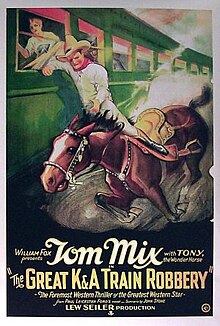The Great K & A Train Robbery
This article needs additional citations for verification. (August 2014) |
| The Great K & A Train Robbery | |
|---|---|
 Theatrical release poster | |
| Directed by | Lewis Seiler |
| Screenplay by | John Stone |
| Produced by | Lewis Seiler |
| Starring | |
| Cinematography | Daniel B. Clark |
| Music by | William P. Perry |
Production company | Lew Seiler Productions |
| Distributed by | Fox Film Corporation |
Release date |
|
Running time | 53 minutes |
| Country | United States |
| Languages |
|
The Great K & A Train Robbery is a 1926 American Western silent film directed by Lewis Seiler and starring Tom Mix and Dorothy Dwan. The film is based on the actual foiling of a train robbery by Dick Gordon[1] as related by Paul Leicester Ford in his book The Great K & A Train Robbery originally published as a serial in Lippincott's Monthly Magazine in 1896.[2][3][4]
Plot
Following a series of robberies of the K & A Railroad, detective Tom Gordon (Tom Mix) is hired to uncover the mystery. Disguised as a bandit, Tom boards the train of K & A President Cullen. Cullen's daughter, Madge, senses that Tom is not a criminal and soon falls in love with him. Madge is sought after by Burton (Carl Miller), her father's secretary, who is in league with the bandits. Tom eventually discovers his duplicity, and with the aid of Tony, his horse, rounds up the villains and wins the hand of Madge.
Cast
- Tom Mix as Tom Gordon
- Tony the Horse as Tony, Tom's Horse
- Dorothy Dwan as Madge Cullen
- Will Walling as Eugene Cullen
- Harry Gripp as DeLuxe Harry
- Carl Miller as Burton Holt
- Edward Peil Sr. as Bill Tolfree
- Curtis 'Snowball' McHenry as Snowball
- Sammy Cohen as Man in upper berth of train (uncredited)
Future western film icon John Wayne worked as a property assistant (props boy) on the film and appeared as an extra.[5][6]
Film locations
Much of the film was shot on location in and around Glenwood Springs, Colorado.[7] The film is notable for its use of breathtaking locations including shots along the Colorado River.[5] Local residents gathered every day for three weeks to watch Mix and his famous horse, Tony, perform their own stunts.[5] Many locals were used as extras.[7] Mix brought the fifty-five cast and crew members, along with his family, to Colorado in two Pullman train cars along with two special baggage cars.[5][7][8]
- Glenwood Springs, Colorado[5]
- Royal Gorge, Colorado[8]
- Shoshone Dam in Glenwood Canyon[7]
See also
References
- ^ Dick Gordan was at the time the superintendent of the Kansas and Arizona Railroad, and was a Yale graduate where he had played football.
- ^ "Paul Leicester Ford". University of South Carolina Libraries. Archived from the original on July 20, 2011.
{{cite web}}: Unknown parameter|deadurl=ignored (|url-status=suggested) (help) - ^ Barrie, J. M. (1897). "The Versatile Mr. Ford". The Bookman: A Literary Journal. 55: 348–349. Retrieved August 4, 2012.
- ^ "The Great K & A Train Robbery". Progressive Silent Film List. Silent Era. Archived from the original on September 7, 2014.
{{cite web}}: Italic or bold markup not allowed in:|publisher=(help); Unknown parameter|deadurl=ignored (|url-status=suggested) (help) - ^ a b c d e "Western megastar at the Majestic". Cooroy Rag. Cooroy, Queensland. May 25, 2011. p. 23.
- ^ Although Wayne met Tom Mix on the film sets, there was also a story that Wayne acted as Tom Mix's personal trainer, this is disputed by Wayne's ofttime director Henry Hathaway who said: "I'm not sure that Tom Mix actually took Duke on as a trainer. I think it's one of those stories that the studio put into his biographies because it made for a good story." Munn, Michael (2005). John Wayne: The Man Behind the Myth. New York: New American Library (Penguin). p. 17. ISBN 978-0-451-21414-0.
- ^ a b c d Urquhart, Lena M. (1970). Glenwood Springs: Spa in the Mountains. Boulder, Colorado: Pruett Publishing Company. p. 135. OCLC 1813156.
- ^ a b Magill, Frank Northen, ed. (1982). Magill's survey of cinema--silent films - Volume 2. Englewood Cliffs, New Jersey: Salem Press. p. 506. ISBN 978-0-89356-239-7.
